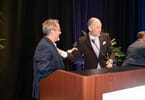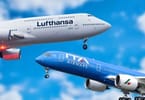NASA announced that it is working with Lockheed Martin on a new project of a commercial jet aircraft capable of breaking the speed of sound without producing the notorious sonic boom.
Any object traveling through the atmosphere faster than the speed of sound generates a shock wave that translates into a loud sound similar to an explosion or a thunderclap called a sonic boom, which affects vast, often heavily populated areas many miles away from the aircraft itself.
The sonic booms were a huge problem for commercial supersonic air travel and forced many Concorde – the British-French turbojet-powered supersonic passenger airliners operated between 1976 and 2003 – flights to slow down over land to below the speed of sound.
The new jet, called X-59, is being developed by Lockheed Martin’s Skunk Works in Palmdale, California, and NASA reports “encouraging” wind-tunnel test results on a small-scale model of its new aircraft. T
he tests confirmed previous NASA computer-modelling estimates showing that the new jet might produce much lower levels of noise, the agency said.
The X-59 ‘Quiet SuperSonic Technology aircraft’ (QueSST) project is in development at least since 2018. The space agency granted $247.5 million to Lockheed Martin’s Skunk Works as part of the project. The resulting X-59 aircraft that is still under development was designed to have a cruise speed of 925 mph, which is 1.4 times more than the speed of sound.
With the X-59, we want to demonstrate that we can reduce the annoying sonic booms to something much quieter, referred to as ‘sonic thumps,’” said John Wolter, lead researcher on the X-59 sonic boom wind-tunnel test.
“The goal is to provide noise and community-response data to regulators, which could result in new rules for overland supersonic flight. The test proved that we don’t just have quieter aircraft design, but that we also have the accurate tools needed to predict the noise of future aircraft,” Wolter added.
NASA and Lockheed Martin expect to begin first flight tests in late 2022. Currently, the full-scale jet model is undergoing durability tests at a Texas facility, the agency said. Flights “over communities around the US” will start in 2024, it added.
IHE Ị GA-Ewepụ na edemede a:
- Any object traveling through the atmosphere faster than the speed of sound generates a shock wave that translates into a loud sound similar to an explosion or a thunderclap called a sonic boom, which affects vast, often heavily populated areas many miles away from the aircraft itself.
- NASA announced that it is working with Lockheed Martin on a new project of a commercial jet aircraft capable of breaking the speed of sound without producing the notorious sonic boom.
- With the X-59, we want to demonstrate that we can reduce the annoying sonic booms to something much quieter, referred to as ‘sonic thumps,'” said John Wolter, lead researcher on the X-59 sonic boom wind-tunnel test.























